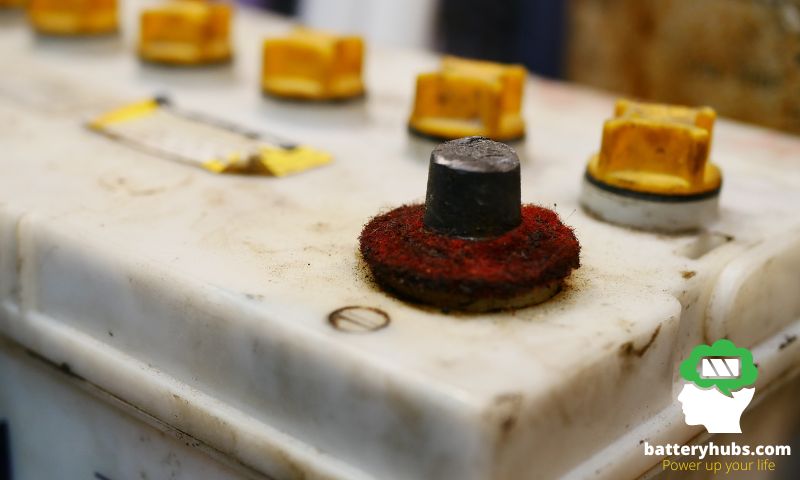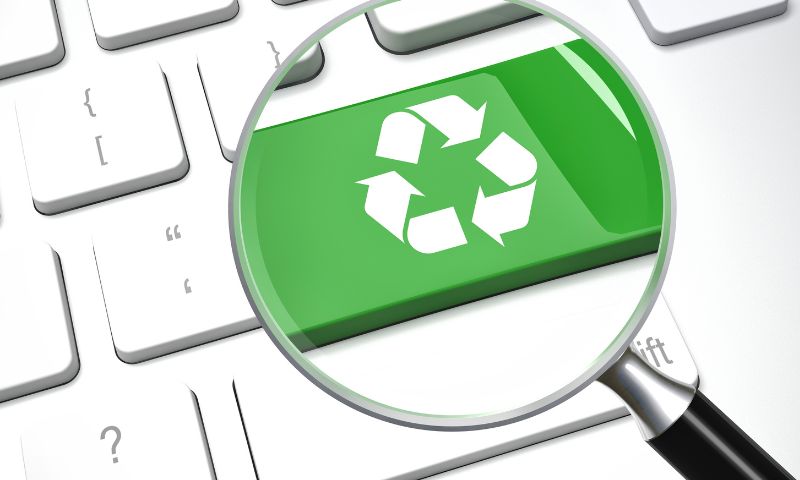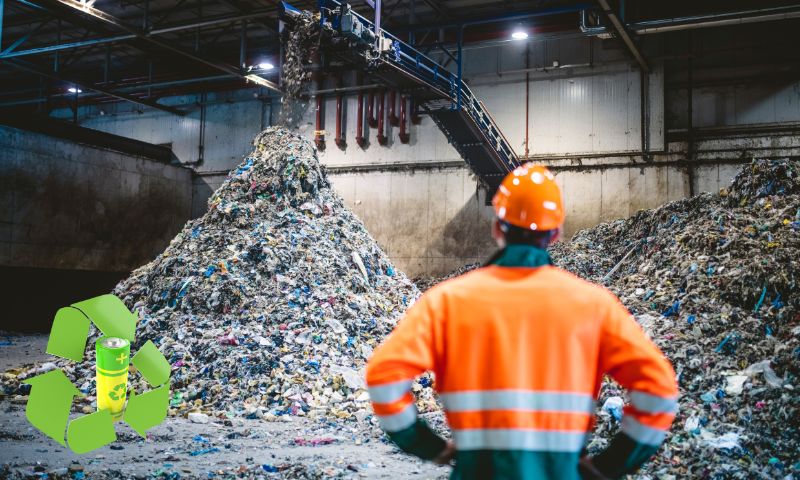I must confess, I’m absolutely electrified by the world of batteries. With years of experience under my belt, I’ve seen how these tiny powerhouses have transformed our lives. In fact, I’ve been tinkering with batteries since I was a kid, and trust me, I’ve had my fair share of shocks along the way!
Now, let me tell you something interesting. According to a report by Fortune Business Insights, the global battery recycling market was valued at $16.19 billion in 2020 and is expected to reach $25.27 billion by 2028. That’s quite an explosive growth, don’t you think?
In this blog, I’ll take you on an electrifying journey to explore battery disposal and recycling. You’ll learn how to safely dispose of batteries, the various recycling processes, and the importance of proper recycling. So, put on your safety goggles, and let’s get started!
What are the different types of batteries?
As someone who’s been knee-deep in the battery world for years, I’ve come to appreciate the sheer variety of batteries out there. Each type has its unique characteristics, advantages, and drawbacks. So, let’s dive in and explore the different types of batteries, shall we?
Alkaline batteries
Alkaline batteries are the most common household batteries, powering devices like TV remotes, toys, and flashlights. They’re cheap and readily available, but they’re not rechargeable.
Fun fact: Alkaline batteries got their name because they use an alkaline electrolyte of potassium hydroxide. Talk about a chemistry lesson!
Lithium-ion batteries
Next up, we have lithium-ion batteries, the rockstars of the battery world! These rechargeable batteries are commonly found in smartphones, laptops, and electric vehicles. They offer high energy density, low self-discharge, and a long lifespan.
Expert quote: Elon Musk once said, “If you want to store a lot of energy in a small volume, lithium-ion is your best bet.”
Lead-acid batteries
You might be familiar with lead-acid batteries as the ones that power your car’s starter motor, lights, and ignition system. These heavyweights are reliable, low-cost, and rechargeable.

Nickel-metal hydride batteries
Nickel-metal hydride batteries (NiMH) are another rechargeable option, commonly found in digital cameras, cordless phones, and power tools. They have a higher energy density than alkaline batteries, but their performance can decrease in cold temperatures.
According to Statista, global NiMH battery sales reached $3.46 billion in 2020.
Button cell batteries
Finally, we have button cell batteries, also known as coin cell batteries. These tiny power sources are used in devices like watches, hearing aids, and key fobs. They come in both disposable and rechargeable varieties.
Now that we’ve covered the different types of batteries, let’s compare them in a handy table, shall we?
| Battery Type | Advantages | Disadvantages |
|---|---|---|
| Alkaline | Cheap, readily available | Non-rechargeable |
| Lithium-ion | High energy density, low self-discharge, long lifespan | Higher cost, potential safety concerns |
| Lead-acid | Reliable, low-cost, rechargeable | Heavy, lower energy density |
| NiMH | Higher energy density than alkaline, rechargeable | Performance can decrease in cold temperatures |
| Button cell | Small size, available in disposable and rechargeable varieties | Limited capacity |
As we transition to the next section, keep these types in mind, as understanding them will be crucial when discussing battery disposal and recycling.
How do you safely dispose of used batteries?
After years of tinkering with batteries, I’ve learned that proper disposal is just as important as choosing the right battery for the job. So, let’s talk about how to safely dispose of used batteries, because nobody wants to be that person who ruins the environment, right?
Taping battery terminals
First things first: taping battery terminals. This might seem like a minor detail, but it’s a crucial step in preventing fires caused by short circuits. Simply place a piece of non-conductive tape (like electrical or duct tape) over the battery’s terminals.

Placing batteries in separate plastic bags
Next up, place batteries in separate plastic bags. It’s a simple but effective way to keep batteries from touching and potentially causing a short circuit. Plus, it helps keep things organized and tidy, which, let’s be honest, who doesn’t love that?
Avoiding disposal in household garbage or recycling bins
Last but definitely not least, avoid disposal in household garbage or recycling bins. Batteries contain hazardous materials that can contaminate soil and water, so it’s essential to dispose of them responsibly.
Expert quote: The EPA states, “Waste batteries can always be recycled or taken to household hazardous waste collection points.”
| Disposal Method | Pros | Cons |
|---|---|---|
| Taping battery terminals | Prevents short circuits and fires | Requires extra effort |
| Placing batteries in separate plastic bags | Prevents contact and short circuits | Consumes plastic bags |
| Avoiding disposal in household garbage or recycling bins | Protects the environment | Requires finding proper disposal locations |
As we wrap up our discussion on battery disposal, remember that disposing of batteries safely is just as crucial as using them efficiently. It’s our responsibility to minimize our impact on the environment and ensure a sustainable future for generations to come.
What are the local and national regulations for battery disposal?
As a battery enthusiast, I’ve always been a stickler for following regulations. It might not be the most thrilling topic, but trust me, understanding the local and national regulations for battery disposal is vital to keep our environment clean and safe. So, let’s dive into it!
EPA guidelines
Let’s start with the big guns – the EPA guidelines. The United States Environmental Protection Agency (EPA) has established rules and recommendations to help us dispose of batteries safely and responsibly.
Expert quote: The EPA suggests, “Waste batteries can always be recycled or taken to household hazardous waste collection points.”

State-specific regulations
Moving on to the nitty-gritty, we have state-specific regulations. Each state may have its own set of rules and guidelines when it comes to battery disposal. So, it’s essential to be aware of your state’s regulations to avoid any legal issues or penalties.
Understanding local recycling programs and facilities
Finally, let’s talk about understanding local recycling programs and facilities. This is where the rubber meets the road, folks. It’s crucial to know your local recycling options, so you can dispose of your batteries with minimal environmental impact.
| Regulation Level | What to Know | Example |
|---|---|---|
| EPA guidelines | National rules and recommendations | Recycling or hazardous waste collection points |
| State-specific regulations | Vary by state, can include bans on certain battery types | California’s Battery Recycling Act |
| Local recycling programs and facilities | Find nearby locations to recycle batteries | Call2Recycle drop-off locations |
As we wrap up our journey through battery disposal regulations, remember that being informed and following the rules is the key to ensuring a sustainable future. So, let’s all do our part and dispose of batteries responsibly, one regulation at a time!
How can you find battery disposal and recycling centers near you?
As someone who’s been in the battery game for quite a while, I know that finding a proper battery disposal and recycling center can feel like searching for a needle in a haystack. But fear not, my fellow battery enthusiasts! I’m here to share some handy tips that’ll help you locate these centers with ease. Let’s dive in!
Online resources, such as Earth911 and Call2Recycle
The internet is a treasure trove of resources, especially when it comes to locating battery disposal and recycling centers. Two fantastic online platforms that I absolutely swear by are Earth911 and Call2Recycle.
Earth911: This website has a fantastic Recycling Search tool that allows you to find recycling solutions for batteries and many other items.
Call2Recycle: With their super convenient Drop-off Locator, you’ll be able to find a recycling center near you in no time.

Local municipal government websites
Another great resource you can tap into is your local municipal government website. They often provide information on recycling programs and facilities in your area. Sometimes, they even have an interactive map or search tool to help you locate the nearest battery disposal center.
Retailers that accept spent batteries
Last but not least, some retailers go the extra mile by accepting spent batteries for recycling. Isn’t that just amazing? Stores like The Home Depot, Lowe’s, and Staples are known to offer battery recycling programs.
| Resource | Description | Example |
|---|---|---|
| Online resources | Websites with search tools for finding recycling centers | Earth911 |
| Local municipal government websites | Official websites with information on local recycling programs | NYC Department of Sanitation |
| Retailers | Stores that accept spent batteries for recycling | The Home Depot |
And there you have it, folks! With these resources at your disposal, finding battery disposal and recycling centers near you should be a breeze. So, go on and recycle those batteries like a pro, because you’ve got this!
What is the process of recycling batteries?
Hey there, fellow battery aficionados! As a seasoned battery expert, I’ve been around the block when it comes to recycling these little energy powerhouses. Trust me, the process is a lot more fascinating than it sounds! Let’s explore the nitty-gritty of battery recycling and learn how these used-up batteries are given a new lease on life.
Sorting and separating batteries by type
First and foremost, the recycling process begins with sorting and separating batteries by type. This is a crucial step because different battery chemistries require specific recycling methods. So, it’s essential to segregate them before diving into the actual recycling process.
| Battery Type | Examples |
|---|---|
| Alkaline | AA, AAA, 9V |
| Lithium-ion | Smartphone, laptop, electric vehicle batteries |
| Lead-acid | Car batteries |
| Nickel-metal hydride | Rechargeable AA, AAA, power tools |
| Button cell | Watch, hearing aid batteries |
Mechanical and chemical processes to recover valuable materials
Once the batteries are sorted, it’s time to recover the valuable materials inside them through a combination of mechanical and chemical processes. It’s like a treasure hunt for precious metals!
For instance, lead-acid batteries undergo a process called smelting, where the lead is extracted and refined for reuse. On the other hand, lithium-ion batteries are typically processed through mechanical crushing and hydrometallurgical processes, which extract valuable metals like lithium, cobalt, and nickel.
Ensuring safety and environmental compliance during recycling
Safety first, folks! The recycling process also involves ensuring safety and environmental compliance at every stage. Battery recycling facilities are regulated by organizations like the EPA and must adhere to strict guidelines to prevent environmental contamination and worker exposure to hazardous materials.
Quote: “The recycling process is not only about extracting valuable materials but also about safeguarding the environment and human health.” – Dr. Jane Goodall

And that’s a wrap on the battery recycling process! The next time you drop off your used batteries at a recycling center, you’ll have a deeper appreciation for the amazing journey they’re about to embark on. So, keep on recycling, and let’s give our batteries the second chance they deserve!
What are the benefits of recycling batteries?
As an experienced battery enthusiast, I can’t stress enough the importance of recycling batteries. Not only does it make me feel like a superhero saving the planet, but it also has some real tangible benefits. So, let’s dive into these perks and explore why recycling batteries is a win-win for everyone.
Conserving natural resources
One of the key benefits of recycling batteries is conserving natural resources. By reclaiming valuable materials like lead, lithium, cobalt, and nickel, we can reduce the need for mining and preserve these precious resources for future generations. In fact, recycling just one car battery can save up to 20 pounds of lead! Now that’s some serious conservation.
Reducing solid waste in landfills
Another fantastic perk of recycling batteries is reducing solid waste in landfills. Batteries are like little ticking time bombs of pollution when they’re tossed into landfills. By recycling them, we can significantly cut down on the volume of waste and give our landfills some much-needed breathing room.
Preventing environmental pollution
Speaking of ticking time bombs, preventing environmental pollution is another huge benefit of recycling batteries. When batteries break down in landfills, they can release toxic chemicals that contaminate soil, water, and air. By recycling batteries, we can keep these harmful substances in check and help protect our beautiful planet.
Contributing to a circular economy
Lastly, recycling batteries contribute to a circular economy by keeping valuable materials in circulation. This sustainable model aims to minimize waste and make the most of our resources, leading to a healthier, happier environment for all.
| Benefits of Recycling Batteries | Impact |
|---|---|
| Conserving natural resources | Reduced mining, preservation of resources |
| Reducing solid waste in landfills | Less landfill space required, lower waste management costs |
| Preventing environmental pollution | Cleaner soil, water, and air |
| Contributing to a circular economy | Sustainable resource management, less dependency on virgin materials |
Expert Quote: “Battery recycling is an essential component of a sustainable society, helping to conserve resources, reduce pollution, and promote a circular economy.” – Elon Musk

So, there you have it! Recycling batteries is not just a feel-good activity, but it’s also a powerful way to make a positive impact on our environment. Let’s join forces and recycle our way to a greener, cleaner future!
How can businesses and individuals contribute to responsible battery disposal and recycling?
As a battery aficionado who’s been around the block a few times, I know that businesses and individuals play a critical role in responsible battery disposal and recycling. So, let’s explore some ways we can all make a difference and become battery-recycling superheroes!
Implementing battery recycling programs at the workplace
One of the best ways to contribute to responsible battery disposal is by implementing battery recycling programs at the workplace. Companies can set up designated collection bins for used batteries and partner with local recycling centers to ensure they’re properly processed. This not only helps businesses reduce their environmental footprint but also sets an excellent example for employees and customers alike.
Educating consumers about proper battery disposal
Educating consumers about proper battery disposal is essential to keeping harmful chemicals out of our environment. Businesses can share information on proper disposal methods through their marketing materials, websites, and social media channels. By raising awareness and providing helpful tips, we can empower individuals to become responsible battery recyclers.
Promoting the use of rechargeable batteries
Lastly, we can all contribute to responsible battery disposal by promoting the use of rechargeable batteries. These eco-friendly alternatives last longer and reduce the overall number of batteries that need to be disposed of, which means less waste and pollution. Plus, they’re a great way to save money in the long run!
| Ways to Contribute | Impact on Battery Disposal & Recycling |
|---|---|
| Implementing recycling programs at the workplace | Proper disposal, reduced environmental footprint |
| Educating consumers | Increased awareness, responsible recycling habits |
| Promoting rechargeable batteries | Less waste, reduced pollution |
Expert Quote: “Businesses and individuals have a crucial role to play in responsible battery disposal and recycling. Together, we can make a significant positive impact on our environment.” – Jennifer Granholm, U.S. Secretary of Energy
In conclusion, we all have the power to make a difference when it comes to responsible battery disposal and recycling. Whether you’re a business owner, employee, or just someone who cares about the environment, let’s join forces and create a greener future for all!
Are there any innovations in battery recycling technology?
As someone who’s been knee-deep in the battery world for years, I’m always on the lookout for innovations and breakthroughs in battery recycling technology. And let me tell you, folks – the future is looking bright! So, buckle up, and let’s dive into some exciting developments in the world of battery recycling.
Emerging recycling technologies and processes
Emerging recycling technologies and processes are revolutionizing the way we recycle batteries. Some of these game-changing techniques include:
- Hydrometallurgical processing: This method uses water-based chemistry to extract valuable metals from batteries, offering a more environmentally friendly approach.
- Direct cathode recycling: This cutting-edge process skips the smelting step, preserving the cathode material and significantly reducing energy consumption.
These innovations are transforming the battery recycling landscape and pushing us toward a greener future.
The Role of Research and Development in battery recycling
Research and development play a crucial role in advancing battery recycling technology. Governments, academic institutions, and private companies are all investing in R&D to discover new, efficient, and eco-friendly ways to recycle batteries. This collective effort is driving the adoption of sustainable practices and reducing the environmental impact of battery disposal.
Potential for improving recycling efficiency and reducing environmental impact
With these technological advancements, there’s tremendous potential for improving recycling efficiency and reducing environmental impact. New recycling processes can help conserve natural resources, minimize pollution, and support the circular economy, ensuring a brighter future for our planet.
| Innovation | Environmental Impact | Recycling Efficiency |
|---|---|---|
| Hydrometallurgical processing | Eco-friendly | High |
| Direct cathode recycling | Reduced energy consumption | High |
Expert Quote: “Innovations in battery recycling technology have the potential to revolutionize the industry, resulting in more efficient processes and reduced environmental impact.” – Dr. Linda Gaines, Argonne National Laboratory
In a nutshell, the world of battery recycling is evolving rapidly, thanks to groundbreaking innovations and tireless research efforts. As we continue to push the boundaries of what’s possible, we’re paving the way for a more sustainable and eco-friendly future. So, let’s charge ahead and embrace these exciting advancements!
What is the future of battery disposal and recycling?
As a seasoned battery aficionado, I can’t help but get excited about the future of battery disposal and recycling. With new technologies, increasing awareness, and global initiatives, we’re on the verge of a new era in sustainable battery management. So, let’s dive into what’s in store for the future of battery disposal and recycling, shall we?
Increasing demand for sustainable battery disposal solutions
In today’s eco-conscious world, there’s a growing demand for sustainable battery disposal solutions. People are becoming more aware of the environmental impact of battery waste, and they’re eager for greener alternatives. This demand is driving innovation and pushing manufacturers, governments, and recycling facilities to adopt sustainable practices. It’s a win-win situation for our planet and future generations!
The growth of electric vehicle battery recycling
The growth of electric vehicle (EV) battery recycling is another fascinating aspect of the future of battery disposal. With the rapid rise of EVs, there’s an increasing need for effective recycling methods for lithium-ion batteries. We’re already seeing startups and established companies investing in advanced recycling technologies to tackle this challenge head-on. So, buckle up – the EV battery recycling revolution is just getting started!
Global efforts to improve battery recycling infrastructure
Global efforts to improve battery recycling infrastructure are also shaping the future of battery disposal and recycling. Governments worldwide are implementing regulations and funding initiatives to boost recycling rates and infrastructure. These efforts are not only improving the efficiency of battery recycling but also helping to reduce the environmental impact of battery waste. It’s truly a global movement for a more sustainable future!
| Aspect | Future Impact | Key Driver |
|---|---|---|
| Sustainable Battery Disposal Solutions | Increased Demand | Environmental Awareness |
| EV Battery Recycling | Rapid Growth | Electric Vehicle Adoption |
| Global Battery Recycling Infrastructure | Improvement | Government Initiatives |
Expert Quote: “The future of battery disposal and recycling will be defined by our ability to innovate, adapt, and adopt sustainable practices in response to increasing demand and evolving technology.” – Dr. Christina Lampe-Önnerud, CEO, Cadenza Innovation
In conclusion, the future of battery disposal and recycling looks bright, with sustainable solutions, electric vehicle battery recycling, and global efforts to improve infrastructure. As we embrace these changes, we can look forward to a more eco-friendly world where responsible battery management is the norm. The future is now, folks – let’s make it count!
Conclusion
Well, my fellow battery enthusiasts, we’ve had quite the electrifying journey together, haven’t we? We’ve explored the ins and outs of battery disposal, recycling, and the innovations shaping their future. With increased awareness, cutting-edge technologies, and global efforts, we’re moving towards a world where responsible battery management becomes second nature. So, let’s embrace these changes, support sustainable practices, and spread the word about responsible battery disposal and recycling. Together, we can power a greener future for our planet and generations to come. Here’s to a bright, battery-powered future!
Now that we’ve covered the essentials of battery disposal and recycling, you might be curious to explore even more about these energy-packed wonders. I’ve got you covered! If you’re interested in learning the basics, check out our comprehensive guides on how batteries work and what form of energy batteries store. To delve deeper, we have a fascinating article on the environmental impact of batteries, as well as a battery chemistry comparison that will help you make informed decisions about which type to choose.
For those who love rechargeable batteries, don’t miss our articles on how rechargeable batteries work, how they get recharged, and how long they last when in use. We even have guides on specific battery types, like AA batteries, and insightful articles on anodes and cathodes.
Lastly, don’t forget to check out our battery maintenance and care tips to ensure your batteries stay charged and ready for action. With all this knowledge at your fingertips, you’ll be a bona fide battery expert in no time! Happy reading, and remember: when it comes to batteries, we’re your one-stop resource.
FAQ
Q: How can we create awareness about battery disposal and recycling?
A: To create awareness about battery disposal and recycling, we can:
- Utilize social media platforms to spread the message.
- Collaborate with schools and educational institutions to include battery recycling topics in their curriculum.
- Host community events and workshops focused on battery disposal and recycling.
- Encourage businesses to implement battery recycling awareness programs for their employees.
Q: Are there any global initiatives to promote battery recycling?
A: Yes, global initiatives to promote battery recycling include:
- International partnerships and collaborations for sustainable battery disposal and recycling.
- The role of non-governmental organizations (NGOs) and environmental groups in promoting battery recycling.
- Government policies and incentives to support battery recycling efforts.
Q: How can innovative battery designs contribute to improved disposal and recycling practices?
A: Innovative battery designs can contribute to improved disposal and recycling practices by:
- Developing easily recyclable battery materials.
- Designing batteries for easier disassembly and recycling.
- Exploring the potential of biodegradable batteries to reduce environmental impact.
Q: How can consumers make informed choices about battery usage and disposal?
A: Consumers can make informed choices about battery usage and disposal by:
- Reading and understanding battery labels and recycling symbols.
- Researching battery disposal and recycling options in their local areas.
- Choosing rechargeable batteries and eco-friendly alternatives when possible.
Q: What are the challenges faced by the battery disposal and recycling industry?
A: The challenges faced by the battery disposal and recycling industry include:
- Managing the growing volume of used batteries.
- Ensuring the safety of workers and the environment during recycling processes.
- Addressing the need for more efficient and cost-effective recycling methods.
- Adapting to changing regulations and industry standards.
Q: How can we overcome the challenges in battery disposal and recycling?
A: To overcome the challenges in battery disposal and recycling, we can:
- Invest in research and development to improve recycling processes and technologies.
- Establish international cooperation and knowledge sharing among industry stakeholders.
- Encourage public-private partnerships to develop innovative solutions and strategies for battery recycling.
- Implement effective policies and regulations to support the growth of the battery disposal and recycling industry.
